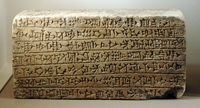- Introduction
- Further information

Old Elamite scribes adopted the cuneiform script for their language from southern Mesopotamia around 2300 BC. Cuneiform is not the only writing system found in Elam, since a number of inscriptions of the fourth and third millennia BC in Proto-Elamite script are known from various sites (see Proto- Elamite for details). The cuneiform script used in Elam comes in two varieties: Akkadian cuneiform (3rd-2nd millennia BC) and Elamite cuneiform (1st millennium BC). The cuneiform sign inventory, which was originally created for Sumerian, was considerably simplified by the Elamites in order to register their language, but the script does not provide an idea about the real pronunciation. Elamite cuneiform includes characters with syllabic values (syllabograms), signs indicating words (logograms), and signs indicating semantic categories (determinatives). The sign inventory comprises CV and VC signs for the vowels a, i, and u, and few signs for the vowel e. Syllabograms cover all the consonant sounds which are supposed for Elamite (b, d, g, ḫ, k, l, m, n, p, r, s, š, t, z). In general, the script does not appear to be suited to the Elamite phonetic system. Determinatives, which diverge from those of the Mesopotamian cuneiform, are very few and their numbers decrease to fewer than ten during the Achaemenid Elamite phase. Polyphony and homophony, which are the main peculiarities of the Mesopotamian cuneiform system in general, are elements of minor importance in the Elamite script and tend to be eliminated in Achaemenid Elamite writing. The number and shapes of signs tend to diverge from the Mesopotamian cuneiform tradition. Also the phonetic values of signs and the number of logograms (Sumerograms) in use are different from the ones of the Mesopotamian writing system. In the Middle Elamite period, for example, the cuneiform writing system consists of a limited repertoire of phonetic signs and few logograms. In the first half of the first millennium BC some Elamite cuneiform signs show a degree of simplification which resembles that which characterized the contemporary Neo-Assyrian forms, as witnessed by the administrative texts from Malyan. This was probably due to the growth of Assyria as a political and military power in the Near Eastern scenario. Elamite cuneiform runs left to right and top to bottom as in Mesopotamian cuneiform script.
Go to the online resources.
Online resourcesPhoto Gallery
List of symbols
Examples of writing
Bibliography
Map of places
